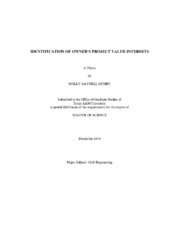| dc.description.abstract | Identifying the unique ways in which a project can add value to an owner’s organization
is an essential part of project delivery. Every project has defined requirements, such as
budget, schedule and engineering specifications that must be met; but there are other
attributes of a project that are not always immediately evident; yet, when implemented,
can add significant value. A delivered project that meets cost, schedule, engineering and
operational requirements is not necessarily a project that provides the most value
possible. To maximize the value of a project, it is first necessary to identify the ways in
which it can add value. Only after that can an effective strategy be developed to exploit
fully the value-adding potential of a project. However, because these value adding
attributes, or value interests, are not always driven by operational or engineering
requirements, they can be difficult to identify. Identification begins with understanding
what aspect of a project drives the value interests. Since a single owner may engage in
different types of projects and the value set of one may not be the value set of another, it
is logical then to conclude it is characteristics of the project itself, not the owner, that
drive the presence of value interest. It is this hypothesis, that project characteristics
drive value interests, which is presented and validated in this thesis. The hypothesis is supported through the development of a mathematical model in which the parameter
estimates show specific project characteristics are significant in explaining the
importance of individual value interests to a project. The model was developed through
binary logistic regression of industry survey data, and validated statistically and
empirically. A sensitivity analysis showed the key cost- and schedule-related value
interests are not significantly sensitive, and an examination of the parameter estimates
showed realistic and common sense relationships are present. The methodology
presented here shows that value interests are, indeed, driven by project characteristics.
However, there is neither a single characteristic nor a standard set of characteristics that
drive all value interests. Instead, each value interest has its own unique combination of
driving characteristics. | en |


